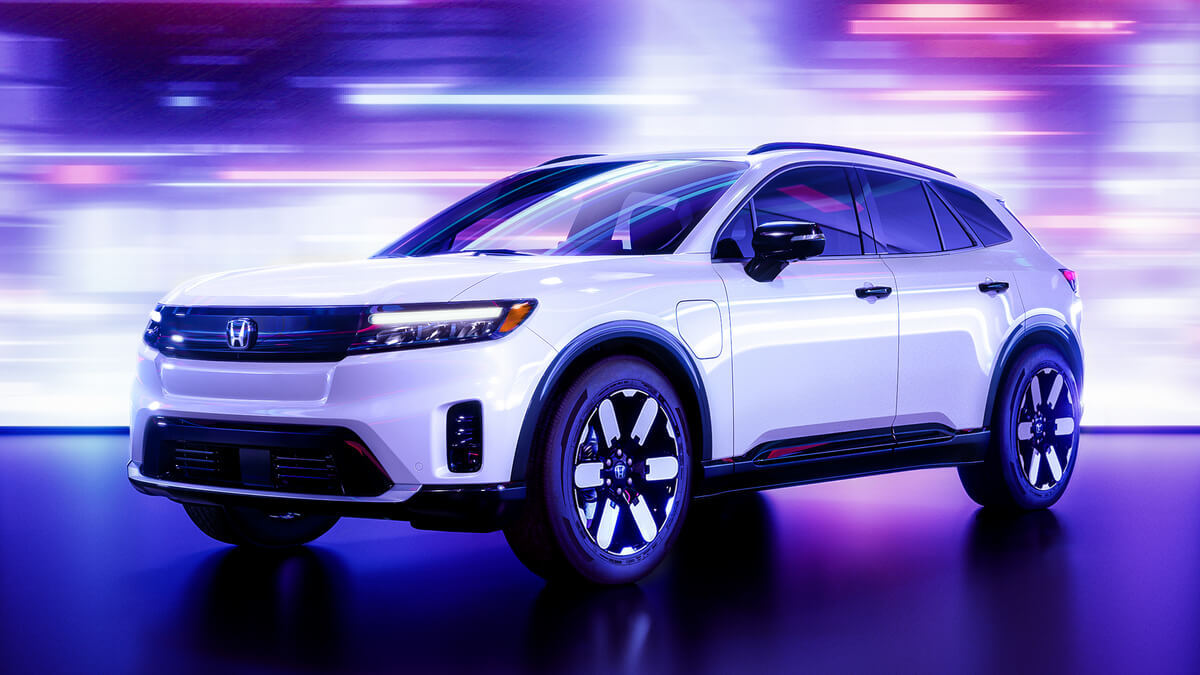Ferrari F355 driving the iconic V8. As prices climb and rose-tinted spectacles fall firmly into place, we investigate whether the F355 is worthy of its icon status.
‘AS ICONS GO, FEW ARE MORE WORTHY THAN THE GLORIOUS F355’
style=”flat” size=”4″]The Cairngorms must surely be one of the most beautiful places on the planet. Whether you’re standing in the shadow of Braemar Castle, dazzled by the sunlight dancing off the River Dee or, like today, on a surprisingly brisk autumnal morning, high up in the mountains with the impression of standing on top of the world, it’s utterly captivating. No wonder the Queen likes to spend time here. You would, too, and for one other significant reason that I suspect we’d have no trouble agreeing on: the Old Military Road, a spectacular ribbon of asphalt that runs up the spine of this National Park. It has everything you’ve ever dreamed of in a road.
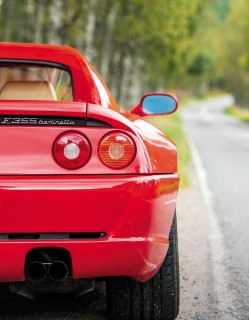
Today, however, the scenery has competition. It’s in the form of an unfashionably small, low, red projectile that’s disarmingly handsome. As far as the subjects of ‘Icon’ features go, few are more worthy than Ferrari’s glorious F355 – a pivotal machine in the history of the most famous car company of them all.
‘Want One’, screamed the cover of the July 1994 issue of Performance Car magazine (evo’s forefather) as it clanked through our letter box. I reached it before the dog, clocked the ‘Ferrari’s £84,000 bargain’ sub-heading with mouth agape, then read and re-read the feature aboard the bus bound for secondary school. From that day onwards, I have lusted after this relatively simple supercar, watched values plummet but still remain out of reach, and then seen those prices accelerate away once again. Despite these towering expectations, driving one has never been a disappointment. Today, on this road, I’m genuinely fearful the needle on the evometer might bend and break against the stop.
The roots of the F355 have become the stuff of motoring lore, recited by every bar-room expert. The 348, so the legend goes, was a stinker. Now, I’m not saying those early 348 TBs weren’t poor, but, like a lot of performance car history, perceived truths become distilled and streamlined into a simple narrative all too easy to repeat. A late 348 GTB is by no means a bad car, but the early 348 did look half-hearted, even complacent, next to Honda’s sparkling NSX, a car that redefined the concept of a useable supercar. The 348 was neither quick enough nor useable enough, and simply not very nice to drive quickly. Ferrari needed a riposte, and damn quickly, the result being a very thorough evolution of the 348: the F355. Although closely related to those late-model 348s, the F355 was a massive step forward and also heralded the return of the beautiful Ferrari after the brash brutality of the 1980s machines.
I must have missed an entire GCSE Geography module swatting up on the new F129B V8 engine. Ferrari had looked to its contemporary V12 F1 programme, adopting five-valve-per-cylinder heads that helped raise the rev limit to a stunning 8500rpm. Titanium rods featured, too, while a 2mm increase in bore took the overall capacity from 3.4 to 3.5 litres. The result was 375bhp, a substantial increase over the Ferrari 348GTB’s 312bhp, giving the F355 the highest specific horsepower per litre of any naturally aspirated engine on sale, McLaren F1 included.

The steel monocoque body, tubular steel rear subframe and unequal-length wishbones were all Italian supercar staples left fundamentally alone, but Ferrari worked on everything else, rethinking the chassis again from the GTB, incorporating bigger alloy wheels, two-stage electronic dampers and power steering. The gearbox was now rod-operated, not a cable mechanism as on the 348, while more emphasis was placed on aerodynamics with a neat rear spoiler incorporated into the body, and crucially, a flat undertray.
What, then, of that body? The overall shape is surprisingly cab-forward in profile, while the frontal aspect does rather date the car with its long, flat snout hiding pop-up lights – technology from another, distant age. Things get sexier around the sides, with the crisp flying buttresses (the last V8 Ferrari to feature this styling device, and also the F355’s biggest corrosion weak-spot) and the loss of the 348’s side-strakes allowing clean, gaping intakes. But for me the real beauty of the F355 is its bum, specifically the form of those rear wheelarches, their curvature and the perfect bone-line that runs through them, then the way it all flows effortlessly, coquettishly into that flipped-up spoiler. This F355’s Crema leather seats are probably what you’d visualise if I said ‘classic Ferrari interior’. The cabin architecture is disarmingly simple, almost slabby around the upper ring of the cockpit, and really quite subtle with no outlandish features. There is one element, though, that gets the blood pumping in anticipation: an open-gate manual gearbox.
When the F355 was launched at the Geneva motor show in 1994, it was available only with a six-speed manual gearbox and in Berlinetta (coupe) or GTS (targa roof) form, with a full convertible (the Spider) arriving the year after. The devil’s work /shiny bright future (delete as applicable) arrived in 1997 in the form of the F1 gearbox, Ferrari’s first attempt at a single-clutch automated transmission and developed from its pioneering work in F1 during the 1989 season. By the time the F355 arrived, any Grand Prix team worth its grid position had a semi-automatic gearbox.
Driving the F355 is really easy but never anything other than special. There is no form of electronic safety net, but, for reasons I’ll come to in a little while, that’s not a problem – certainly not in the dry. The clutch is agreeably light, and the car is soon moving forwards, requiring your first Ferrari opengate gearchange. It feels divine. If you’re expecting an awkward resistance then fear not; the mechanism is fast and, with the guidance of the gate, there’s no prospect of mis-slotting a gear. Forget the click-clack cliché, the spindly lever makes more of a sckreech sound as it squeezes between the metal cutaways, a noise that would be comparable to fingers down a blackboard were it not for the satisfyingly tactile sensations of mechanical components meshing precisely with one another.
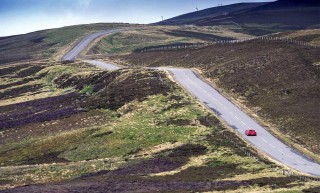
The flat-plane-crank V8 doesn’t actually sound that good when you’re just ambling along. It’s a busy sort of engine note, hard-edged like the tip of an industrial drill. It’s only when you breach 5500rpm that it homogenises into something petrolheads like us would call musical, which is precisely the point at which the F355 pulls itself taut and accelerates with real determination. To make genuinely rapid progress in an F355 you need to keep the engine spinning between 6000rpm and a little over 8000rpm. Oh man, what a chore. Only kidding – driven thus, an F355 is pure bliss, with seemingly no limit to the speed with which cogs can be swapped, the engine revving tirelessly, the noise consuming everything.
I want you to do something for me now. Just for a moment stare without distraction at Aston Parrott’s extraordinary photography on these pages, then close your eyes. Imagine the ‘little’ V8 spinning furiously, nuzzling up against the red line. Hear it? Notice how the sound drifts off in waves over the hillside as the car passes, how it adopts a quadraphonic effect over little stone bridges and against dense, dark forests bordering the verge. On and on the little red Ferrari goes, a tiny speck in an endless landscape, yet dominating its surroundings with its howl. That’s what driving this car on this road is like.
The F355 isn’t intimidating partly because it doesn’t feel that potent through the mid-range. This may have something to do with this example being a later model, or a ‘5.2 Motronic’ car to be precise. F355 aficionados will be aware that, when the car was launched, it was equipped with a more primitive Bosch 2.7 Motronic system that had two air mass flow sensors, two fuel pumps and two lambda sensors among other differences, all clearly visible in the engine bay. There is no definitive opinion on this one, but a vague consensus among marque experts suggests that ‘2.7’ cars have a sharper throttle response and more power, despite the official claims remaining the same.
The difference can be anything from ‘so little that you won’t notice it’ to ‘as much as 30bhp’, depending on which expert you happen to be talking to. The advantages of the 5.2 Motronic setup include a smoother delivery and idle, and they’re cleaner, too. The changeover happened for the 1996 model year so that Ferrari could sell the car in the US, and around the same time the delectable Momo steering wheel was changed for a clumsy airbag-equipped design.
Top: red line isn’t till 8500rpm, and engine doesn’t really come alive until the needle passes 6000rpm. Above: F355 was one of the first road cars to use underbody aero to create downforce. Left, from top: wonderful open-gate manual gearbox is just one reason to love this F355; classic Crema leather looks fab, airbagged wheel less so; V8 is 3.5 litres and has five valves per cylinder (hence 355).
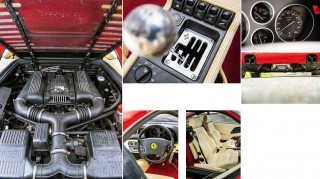
Whatever the setup, the quoted maximum torque figure for the F355 is a pretty humble-sounding 268lb ft at a peaky 6000rpm. Consider, too, that the quoted dry weight is 1350kg, so likely to be c1450kg with a full load of fluids, and suddenly that crucial but rarely quoted torque-to-weight figure doesn’t look terribly impressive. Compared with the kind of volcanic mid-range thrust we expect from a modern supercar, this undoubtedly gives the F355’s chassis an easier time of things, but that doesn’t mask the fact that it’s a gem all the same. After the twitchiness of a 348 TB, it takes only 500 yards to get a sense that the F355 is going to be a faithful friend: malleable, exploitable, enjoyable. It rides like a pliantly suspended sled, with the feeling that the track is broad and with a big, sticky tyre right at the extremity of each corner.
The winters really take their toll on the road surface around here, so for most of the time I leave the dampers in their normal setting, trading body roll for some compliance over the worst of the rutted sections. Like this, the car rides really well, which must make it comfortable as a long-distance machine (aided by a pedal box nowhere near as offset as you might expect). The steering is reasonably light, with the whole car feeling delicate to the touch: whether moving the gearlever around the gate or turning into a corner, the F355 is a car you tend to drive using just your fingertips once familiarity sets in.
Push harder and the car’s limits are that much more visible, albeit much lower, than in a ‘modern’. The Old Military Road has a habit of dropping random S-bends into ostensibly flatout sections, and there are some steep, twisting descents too. The F355 pivots somewhere just aft of the driver’s spine, and as it begins to reach the limit of grip it rolls further, leaning on the outer edge of the tyre, starting to arc a wider line at the rear. It’s a process that has several clearly defined stages, in the dry at least, which makes it an easy car to ‘read’.
My only wish – OK, bar a little more torque – is for a slightly quicker steering rack. The F355 is always beautifully poised on the road, but that initial turn-in to a corner is never quite as immediate as you’d hope, always requiring a few degrees more lock than the brain anticipates. The car is never quite as agile in reality as you know deep down it could be.
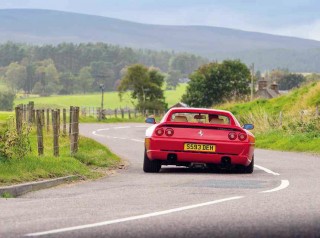
The answer could potentially have been found in the F355 Challenge, the one-make race car built up in period from a Berlinetta with a kit of official parts. Ferrari never made an F355 Challenge Stradale, and, having driven a road-legal example of the race car, I can tell you that this is a tragedy worth flooding your garage with tears over (to the backing track of some tragi-opera). That early Challenge car – lighter, with any hint of steering vagueness banished, and without the rear wing and stripped-out interior of later Challenge cars – remains among my all-time top-three drives. The Fiorano handling pack, available late in the F355 production run, also got that quicker steering rack, but only around 14 cars soequipped made it to the UK.
Still, I can forgive the steering, for it’s a minor flaw akin to a miniscule slip of the brush on a mesmerising portrait from a grand master. The F355 bridges the gap between old Ferrari and new; between quaint, classic, small V8s and the recent 200mph V8 supercars; the last hand-built Ferrari, but also the first to really embrace modern technology. I still live in hope that, one day, one of the 11,273 F355s built will have my name on the V5, and this drive has predictably only served to galvanise that ambition. If you share the same dream, I promise you won’t be disappointed.
With many thanks to the owner of this Ferrari F355 Berlinetta for allowing us to enjoy his wonderful car.
TECHNICAL DATA SPECIFICATIONS Ferrari F355 Berlinetta
Engine V8, 3496cc
Power 375bhp @ 8250rpm
Torque 268lb ft @ 6000rpm
Transmission Six-speed manual, rear-wheel drive
Front suspension Double wishbones, coil springs, adaptive dampers, anti-roll bar
Rear suspension Double wishbones, coil springs, adaptive dampers, anti-roll bar
Wheels 7.5 x 18in front, 10 x 18in rear
Tyres 225/40 ZR18 front, 265/40 ZR18 rear
Weight 1350kg (dry)
Power-to-weight 282bhp/ton
0-62mph (0-100kph) 4.7sec (claimed)
Top speed 183mph (295kph) (claimed)
On sale 1994-1999
Value today £70,000+
Rating: 5.0

